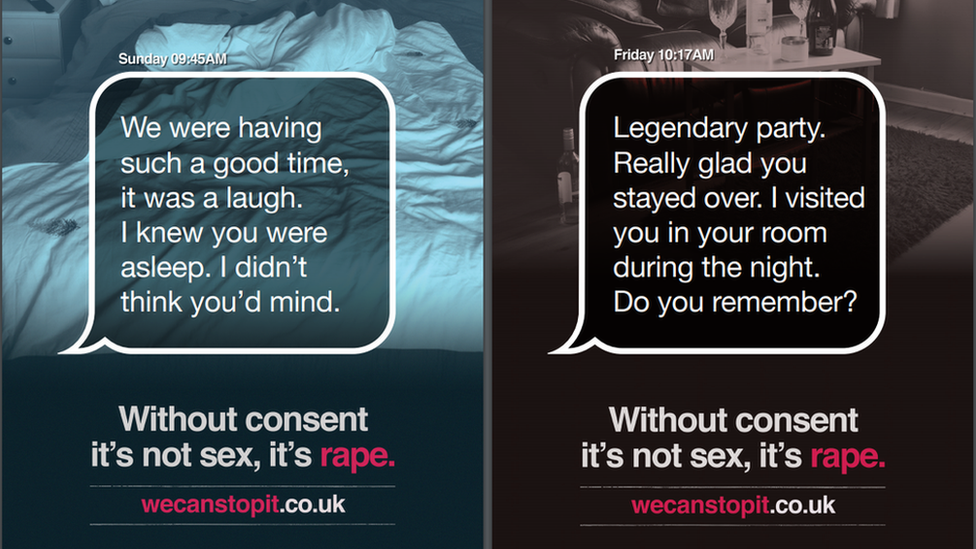BDSM and consent: How to stop rough sex crossing the line into abuse
- Published

When allegations of assault were made against New York's top prosecutor Eric Schneiderman this week, he denied them, saying engaging in non-consensual sex was a line he would not cross.
"In the privacy of intimate relationships, I have engaged in role-playing and other consensual sexual activity. I have not assaulted anyone," he told The New Yorker magazine, which broke the story, external.
Four women say he repeatedly slapped them and one said he insisted she call him "master" in non-consensual situations.
One former girlfriend, Michelle Manning Barish, said: "This was under no circumstances a sex game gone wrong... I did not consent to physical assault." New York prosecutors are investigating the allegations.
This is not the first time a man accused of assault has claimed he was consensually engaging in rough sex (in Mr Schneiderman's case, he was in a sexual relationship with three of his four accusers; a fourth woman said he hit her after she rebuffed him).
In 2014, Canadian musician and former radio host Jian Ghomeshi was acquitted of multiple sexual assault charges after several women claimed he had choked, slapped and bitten them without warning or consent.
And in 2015, nine women accused adult film star James Deen of assaulting them and not respecting their sexual boundaries or safe words. He denied the accusations and no charges were ever brought.
In recent days, Mr Schneiderman's case has come under close scrutiny in the BDSM community, an overlapping acronym for bondage, discipline, dominance, submission, sadism and masochism.
The BBC spoke with sex experts and prominent members of the community who said full and free consent was a vital element of the practice, in which partners consent to inflicting or enduring pain or physical abuse.
They said they were keen to explain what does, in fact, make a consensual BDSM relationship.

Communication and understanding develops trust between BDSM couples, experts say
"Stuff like this, doesn't give [BDSM] a good name," said Allen TG, one of the directors of Torture Garden, the world's largest fetish club. "Generally in a BDSM relationship, there are fairly strong guidelines - it's all about consent."
Many people who practise BDSM, which is an aspect of kinky sex, may not consider themselves to be in a BDSM relationship or an active member of the community because the exploration of boundaries in sexual imagination are deeply personal and subject to individual tastes.
Certified sex coach Sarah Martin explained: "A lot of people start with something as simple as a blindfold, and it can be erotic and connecting, it doesn't have to involve equipment or paraphernalia.
"Consent should be freely given, and it should be reversible at any point," said Ms Martin, who is also executive director of the World Association of Sex Coaches. "Many people think that if you consent, that you agree until it's done, but that's not at all how it's done."

BDSM vocabulary
Kink - a broad term that usually encompasses sexual acts considered outside the norm
BDSM - this acronym is described as a pre-agreed power exchange, sometimes not explicitly sexual
Dominant and submissive - the names for the roles individuals enact during BDSM practice
Play and scene - BDSM participants describe themselves as playing in a scene
Munch - a casual social meet-up for people involved in or interested in BDSM
Vanilla - refers to someone, or sex, that is not kinky
Safe words - words or a gesture pre-agreed with your partner to alert them to your physical and mental limits
Aftercare - argued to be just as important as the scene, this is personal to the individual but may involve blankets, cuddles, conversation and a cup of tea to ease both participants physically and emotionally back to normality

To exercise informed consent, the sub - the abbreviated form for submissive - needs to know what activities will take place and how.
"Different bodies respond to touch in different ways," explained the sex coach. "You may agree to spanking, but then if your partner uses a paddle, then that's not informed consent."
"It is entirely unacceptable to 'surprise' someone with slaps, whips, blindfolds, or anything like that if you haven't spoken to them about it before," said anonymous sex blogger Girl on the Net.
Mr Allen added that there's a misconception that the dominant partner - or dom as they are sometimes called - is the one with control.
"A good dom is giving pleasure to the submissive, and that's what gives the dom pleasure. If it's only going one way, then that's when it's not healthy," the fetish club organiser said.
Clinical sexologist Dr Celina Criss agreed. "It can be said that the power in a scene lies with the submissive because nothing can happen without their agreement."
Playing it safe
Communication and understanding are cornerstones to any healthy relationship, the experts say. Because there is intimacy in divulging personal fantasies, a level of trust is also developed when establishing a BDSM relationship.
"People who participate in the BDSM community pride themselves on their communication and negotiation skills," said Dr Criss. "Ideally, negotiation happens before partners ever touch each other."

Traffic light colours are common safe words used between BDSM partners
Girl on the Net recommended listening carefully, reading the other person's body language and tone, asking questions to check in and making sure they're comfortable at every step of play.
The anonymous author also explained that in BDSM there are "pre-agreed safe words or gestures that mean - stop this immediately".
A simple and common example of this is the traffic light system, using colour cards or the words themselves. Green means "that's great, keep going", explained Ms Martin. "Yellow is a check in, but not necessarily a stop, and red is no - it means stop, it means it's done."
So why isn't "no", as a word, enough?
"For some people, saying no but not being listened to may be part of the sexual fantasy," explained the sex coach. "But you've negotiated this ahead of time so the dominant knows that's part of your cathartic pleasure."
Christa Gheista, a sex worker activist and former dominatrix, explains the rules of consent
Crossing the line
Overstepping a sexual boundary can and does happen, but sexologist Dr Criss said an adherence to communication, negotiation and repeated mutual consent keeps rough sex from becoming wilful abuse.
"People who are not involved in BDSM are likely to have many misconceptions based on what they've seen in movies," she said, referring specifically to the popular erotic romance novel and film series Fifty Shades of Grey.

Ms Martin warned that such mainstream depictions of BDSM relationships are fantasy, and almost never show the level of negotiation and ongoing conversations that shape a successful BDSM experience. She says: "The quickest way for [abuse] to happen is if there isn't communication."
Girl on the Net likened it to a contact sport. "BDSM is to abuse what boxing is to being punched by surprise. The former is done with consent and an understanding of risks. The latter isn't, and is assault.
"I also know that 'BDSM made me do it' has been an excuse used by powerful men in the past to try and dodge accountability for their actions. It's not acceptable... BDSM is not an excuse for abuse."
"It can be sexy, but also deeply caring," explained sex coach Ms Martin. Kinky sex should never be used as a way to defend violent behaviour, she said.
"It makes me feel it makes an attempt to take advantage of general societal ignorance of BDSM," she said.
- Published11 May 2018

- Published8 May 2018

- Published24 April 2013

- Published17 October 2016

- Published8 February 2018

- Published15 February 2018

- Published6 March 2018
